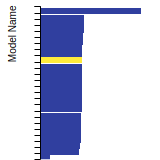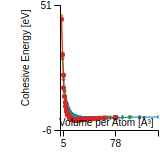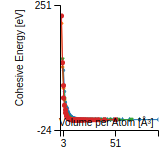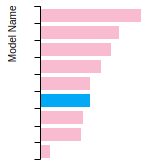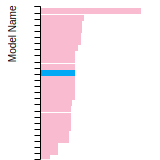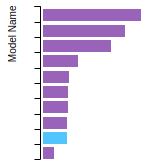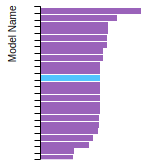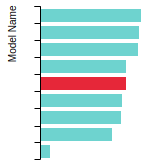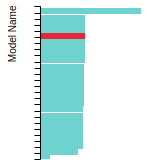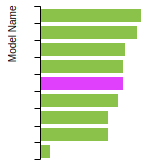 MEAM_LAMMPS_JangKimLee_2018_ZnMg__MO_474962707676_002
MEAM_LAMMPS_JangKimLee_2018_ZnMg__MO_474962707676_002
| Title
A single sentence description.
|
MEAM Potential for the Mg-Zn system developed by Jang et al. (2018) v002 |
|---|---|
| Description
A short description of the Model describing its key features including for example: type of model (pair potential, 3-body potential, EAM, etc.), modeled species (Ac, Ag, ..., Zr), intended purpose, origin, and so on.
|
Interatomic potentials for Mg–Zn binary system has been developed on the basis of the second nearest-neighbor modified embedded-atom method formalism. The potential reproduce the alloy behavior (thermodynamic, structural, and elastic properties of compounds and solution phases) of Mg-Zn alloys well in good agreement with experiments, first-principles and CALPHAD. In the original paper (Jang et al, Calphad, 60, 2018), the applicability of the developed potentials to atom-scale investigations on the slip behavior of Mg-Zn alloys is also demonstrated by showing that the calculated effects of Zn on the general stacking fault energy on the basal, prismatic and pyramidal planes are consistent with first-principles calculations. |
| Species
The supported atomic species.
| Mg, Zn |
| Disclaimer
A statement of applicability provided by the contributor, informing users of the intended use of this KIM Item.
|
None |
| Content Origin | http://cmse.postech.ac.kr/home_2nnmeam |
| Contributor |
Hyeon-Seok Do |
| Maintainer |
Hyeon-Seok Do |
| Developer |
Hyo-Sun Jang Kyeong-Min Kim Byeong-Joo Lee |
| Published on KIM | 2023 |
| How to Cite |
This Model originally published in [1] is archived in OpenKIM [2-5]. [1] Jang H-S, Kim K-M, Lee B-J. Modified embedded-atom method interatomic potentials for pure Zn and Mg-Zn binary system. Calphad. 2018;60:200–7. doi:10.1016/j.calphad.2018.01.003 — (Primary Source) A primary source is a reference directly related to the item documenting its development, as opposed to other sources that are provided as background information. [2] Jang H-S, Kim K-M, Lee B-J. MEAM Potential for the Mg-Zn system developed by Jang et al. (2018) v002. OpenKIM; 2023. doi:10.25950/2b8ee853 [3] Afshar Y, Hütter S, Rudd RE, Stukowski A, Tipton WW, Trinkle DR, et al. The modified embedded atom method (MEAM) potential v002. OpenKIM; 2023. doi:10.25950/ee5eba52 [4] Tadmor EB, Elliott RS, Sethna JP, Miller RE, Becker CA. The potential of atomistic simulations and the Knowledgebase of Interatomic Models. JOM. 2011;63(7):17. doi:10.1007/s11837-011-0102-6 [5] Elliott RS, Tadmor EB. Knowledgebase of Interatomic Models (KIM) Application Programming Interface (API). OpenKIM; 2011. doi:10.25950/ff8f563a Click here to download the above citation in BibTeX format. |
| Citations
This panel presents information regarding the papers that have cited the interatomic potential (IP) whose page you are on. The OpenKIM machine learning based Deep Citation framework is used to determine whether the citing article actually used the IP in computations (denoted by "USED") or only provides it as a background citation (denoted by "NOT USED"). For more details on Deep Citation and how to work with this panel, click the documentation link at the top of the panel. The word cloud to the right is generated from the abstracts of IP principle source(s) (given below in "How to Cite") and the citing articles that were determined to have used the IP in order to provide users with a quick sense of the types of physical phenomena to which this IP is applied. The bar chart shows the number of articles that cited the IP per year. Each bar is divided into green (articles that USED the IP) and blue (articles that did NOT USE the IP). Users are encouraged to correct Deep Citation errors in determination by clicking the speech icon next to a citing article and providing updated information. This will be integrated into the next Deep Citation learning cycle, which occurs on a regular basis. OpenKIM acknowledges the support of the Allen Institute for AI through the Semantic Scholar project for providing citation information and full text of articles when available, which are used to train the Deep Citation ML algorithm. |
This panel provides information on past usage of this interatomic potential (IP) powered by the OpenKIM Deep Citation framework. The word cloud indicates typical applications of the potential. The bar chart shows citations per year of this IP (bars are divided into articles that used the IP (green) and those that did not (blue)). The complete list of articles that cited this IP is provided below along with the Deep Citation determination on usage. See the Deep Citation documentation for more information. 
23 Citations (11 used)
Help us to determine which of the papers that cite this potential actually used it to perform calculations. If you know, click the .
USED (high confidence) P. Yi, T. Sasaki, S. Prameela, T. Weihs, and M. Falk, “The Interplay between Solute Atoms and Vacancy Clusters in Magnesium Alloys,” SSRN Electronic Journal. 2021. link Times cited: 2 Abstract: Atomic-scale calculations indicate that both stress effects … read more USED (high confidence) J.-K. Lee and B.-J. Lee, “The Origin of Activation of Non-basal Slip in Mg-Ce Dilute Alloy: An Atomistic Simulation Study,” Metallurgical and Materials Transactions A. 2021. link Times cited: 9 USED (low confidence) X. Gao, N. Li, Z. Song, K. Wu, Y. Cheng, and B.-yang Xiao, “Atomic structure evolution and linear regression fitting models for pre-breakdown electric field strength of FCC, BCC and HCP metal nano-emitters under high electric field from PIC-ED–MD simulations,” Journal of Physics D: Applied Physics. 2023. link Times cited: 1 Abstract: Multi-scale and multi-physics simulations are carried out fo… read more USED (low confidence) S. Zhang, L. Sun, R. Song, and C. Cai, “Wetting characteristics of Zn on Fe Surfaces and its Influencing Factors: Molecular Dynamics Simulation,” Surfaces and Interfaces. 2023. link Times cited: 2 USED (low confidence) Y. Li et al., “Deposition of Horizontally Stacked Zn Crystals on Single Layer 1T‐VSe2 for Dendrite‐Free Zn Metal Anodes,” Advanced Energy Materials. 2022. link Times cited: 6 Abstract: Owing to the moderate redox potential and high safety, Zn me… read more USED (low confidence) H.-S. Jang, J.-K. Lee, A. J. Tapia, N. Kim, and B.-J. Lee, “Activation of non-basal slip in multicomponent Mg alloys,” Journal of Magnesium and Alloys. 2021. link Times cited: 23 USED (low confidence) H.-S. Jang, D. Seol, and B.-J. Lee, “Modified embedded-atom method interatomic potentials for Mg–Al–Ca and Mg–Al–Zn ternary systems,” Journal of Magnesium and Alloys. 2020. link Times cited: 28 USED (low confidence) R. Boom and F. D. Boer, “Enthalpy of formation of binary solid and liquid Mg alloys – Comparison of Miedema-model calculations with data reported in literature,” Calphad-computer Coupling of Phase Diagrams and Thermochemistry. 2020. link Times cited: 4 USED (low confidence) H.-S. Jang, D. Seol, and B.-J. Lee, “Modified embedded-atom method interatomic potential for the Mg–Zn–Ca ternary system,” Calphad-computer Coupling of Phase Diagrams and Thermochemistry. 2019. link Times cited: 6 USED (low confidence) I. Aslam et al., “Thermodynamic and kinetic behavior of low-alloy steels: An atomic level study using an Fe-Mn-Si-C modified embedded atom method (MEAM) potential,” Materialia. 2019. link Times cited: 12 USED (low confidence) H.-S. Jang and B.-J. Lee, “Effects of Zn on 〈c + a〉 slip and grain boundary segregation of Mg alloys,” Scripta Materialia. 2019. link Times cited: 44 NOT USED (low confidence) H. Mei, L. Cheng, L. Chen, F. Wang, J. Li, and L. Kong, “Development of machine learning interatomic potential for zinc,” Computational Materials Science. 2024. link Times cited: 0 NOT USED (low confidence) H. Zhou, D. Dickel, and C. D. Barrett, “Improving stability and transferability of machine learned interatomic potentials using physically informed bounding potentials,” Journal of Materials Research. 2023. link Times cited: 1 NOT USED (low confidence) N. Gadwala, N. Kumar, and D. Ravinder, “Rare Earth Gd3+-Substituted BiFeO3 Perovskite Nanoparticles: Synthesis, Structural, Optical, and Magnetic Properties,” Brazilian Journal of Physics. 2023. link Times cited: 1 NOT USED (low confidence) B. Yao, Z. R. Liu, D. Legut, and R. F. Zhang, “Hybrid potential model with high feasibility and flexibility for metallic and covalent solids,” Physical Review B. 2023. link Times cited: 0 NOT USED (low confidence) M. S. Nitol, D. Dickel, and C. Barrett, “Artificial neural network potential for pure zinc,” Computational Materials Science. 2021. link Times cited: 11 NOT USED (high confidence) W. Y. Huen, H.-S. Lee, V. Vimonsatit, P. Mendis, and H.-seung Lee, “Transversely isotropic elastic-plastic properties in thermal arc sprayed Al–Zn coating: a microporomechanics approach,” Scientific Reports. 2020. link Times cited: 3 NOT USED (high confidence) M. Alidoust, D. Kleiven, and J. Akola, “Density functional simulations of pressurized Mg-Zn and Al-Zn alloys,” Physical Review Materials. 2020. link Times cited: 5 Abstract: The Mg-Zn and Al-Zn binary alloys have been investigated the… read more NOT USED (high confidence) S.-J. Sun, S. Ju, C.-C. Yang, K.-C. Chang, and I.-J. Lee, “Effects of Strontium incorporation to Mg-Zn-Ca biodegradable bulk metallic glass investigated by molecular dynamics simulation and density functional theory calculation,” Scientific Reports. 2020. link Times cited: 6 NOT USED (high confidence) W. Jian, D. Hui, and D. Lau, “Nanoengineering in biomedicine: Current development and future perspectives,” Nanotechnology Reviews. 2020. link Times cited: 35 Abstract: Recent advances in biomedicine largely rely on the developme… read more NOT USED (high confidence) M. Wu, R. Pan, J. Liang, G. Zhou, L. Ma, and C. Zhang, “Structural, Elastic and Electronic Properties of γ˝ Phase Precipitate in Mg-Gd-Zn Alloy,” Journal of the chemical society of pakistan. 2019. link Times cited: 0 Abstract: The γ˝ phase (Mg4GdZn) precipitate in Mg-Gd-Zn alloy was cal… read more NOT USED (high confidence) M. Zacate, “Modified embedded-atom method potential for cadmium,” Hyperfine Interactions. 2019. link Times cited: 0 NOT USED (high confidence) D. Dickel, M. Baskes, I. Aslam, and C. Barrett, “New interatomic potential for Mg–Al–Zn alloys with specific application to dilute Mg-based alloys,” Modelling and Simulation in Materials Science and Engineering. 2018. link Times cited: 42 Abstract: Because of its very large c/a ratio, zinc has proven to be a… read more |
| Funding | Not available |
| Short KIM ID
The unique KIM identifier code.
| MO_474962707676_002 |
| Extended KIM ID
The long form of the KIM ID including a human readable prefix (100 characters max), two underscores, and the Short KIM ID. Extended KIM IDs can only contain alpha-numeric characters (letters and digits) and underscores and must begin with a letter.
| MEAM_LAMMPS_JangKimLee_2018_ZnMg__MO_474962707676_002 |
| DOI |
10.25950/2b8ee853 https://doi.org/10.25950/2b8ee853 https://commons.datacite.org/doi.org/10.25950/2b8ee853 |
| KIM Item Type
Specifies whether this is a Portable Model (software implementation of an interatomic model); Portable Model with parameter file (parameter file to be read in by a Model Driver); Model Driver (software implementation of an interatomic model that reads in parameters).
| Portable Model using Model Driver MEAM_LAMMPS__MD_249792265679_002 |
| Driver | MEAM_LAMMPS__MD_249792265679_002 |
| KIM API Version | 2.2 |
| Potential Type | meam |
| Previous Version | MEAM_LAMMPS_JangKimLee_2018_ZnMg__MO_474962707676_001 |
| Grade | Name | Category | Brief Description | Full Results | Aux File(s) |
|---|---|---|---|---|---|
| P | vc-species-supported-as-stated | mandatory | The model supports all species it claims to support; see full description. |
Results | Files |
| P | vc-periodicity-support | mandatory | Periodic boundary conditions are handled correctly; see full description. |
Results | Files |
| P | vc-permutation-symmetry | mandatory | Total energy and forces are unchanged when swapping atoms of the same species; see full description. |
Results | Files |
| A | vc-forces-numerical-derivative | consistency | Forces computed by the model agree with numerical derivatives of the energy; see full description. |
Results | Files |
| F | vc-dimer-continuity-c1 | informational | The energy versus separation relation of a pair of atoms is C1 continuous (i.e. the function and its first derivative are continuous); see full description. |
Results | Files |
| P | vc-objectivity | informational | Total energy is unchanged and forces transform correctly under rigid-body translation and rotation; see full description. |
Results | Files |
| P | vc-inversion-symmetry | informational | Total energy is unchanged and forces change sign when inverting a configuration through the origin; see full description. |
Results | Files |
| P | vc-memory-leak | informational | The model code does not have memory leaks (i.e. it releases all allocated memory at the end); see full description. |
Results | Files |
| P | vc-thread-safe | mandatory | The model returns the same energy and forces when computed in serial and when using parallel threads for a set of configurations. Note that this is not a guarantee of thread safety; see full description. |
Results | Files |
| P | vc-unit-conversion | mandatory | The model is able to correctly convert its energy and/or forces to different unit sets; see full description. |
Results | Files |
BCC Lattice Constant
This bar chart plot shows the mono-atomic body-centered cubic (bcc) lattice constant predicted by the current model (shown in the unique color) compared with the predictions for all other models in the OpenKIM Repository that support the species. The vertical bars show the average and standard deviation (one sigma) bounds for all model predictions. Graphs are generated for each species supported by the model.
Cohesive Energy Graph
This graph shows the cohesive energy versus volume-per-atom for the current mode for four mono-atomic cubic phases (body-centered cubic (bcc), face-centered cubic (fcc), simple cubic (sc), and diamond). The curve with the lowest minimum is the ground state of the crystal if stable. (The crystal structure is enforced in these calculations, so the phase may not be stable.) Graphs are generated for each species supported by the model.
Diamond Lattice Constant
This bar chart plot shows the mono-atomic face-centered diamond lattice constant predicted by the current model (shown in the unique color) compared with the predictions for all other models in the OpenKIM Repository that support the species. The vertical bars show the average and standard deviation (one sigma) bounds for all model predictions. Graphs are generated for each species supported by the model.
Dislocation Core Energies
This graph shows the dislocation core energy of a cubic crystal at zero temperature and pressure for a specific set of dislocation core cutoff radii. After obtaining the total energy of the system from conjugate gradient minimizations, non-singular, isotropic and anisotropic elasticity are applied to obtain the dislocation core energy for each of these supercells with different dipole distances. Graphs are generated for each species supported by the model.
(No matching species)FCC Elastic Constants
This bar chart plot shows the mono-atomic face-centered cubic (fcc) elastic constants predicted by the current model (shown in blue) compared with the predictions for all other models in the OpenKIM Repository that support the species. The vertical bars show the average and standard deviation (one sigma) bounds for all model predictions. Graphs are generated for each species supported by the model.
FCC Lattice Constant
This bar chart plot shows the mono-atomic face-centered cubic (fcc) lattice constant predicted by the current model (shown in red) compared with the predictions for all other models in the OpenKIM Repository that support the species. The vertical bars show the average and standard deviation (one sigma) bounds for all model predictions. Graphs are generated for each species supported by the model.
FCC Stacking Fault Energies
This bar chart plot shows the intrinsic and extrinsic stacking fault energies as well as the unstable stacking and unstable twinning energies for face-centered cubic (fcc) predicted by the current model (shown in blue) compared with the predictions for all other models in the OpenKIM Repository that support the species. The vertical bars show the average and standard deviation (one sigma) bounds for all model predictions. Graphs are generated for each species supported by the model.
(No matching species)FCC Surface Energies
This bar chart plot shows the mono-atomic face-centered cubic (fcc) relaxed surface energies predicted by the current model (shown in blue) compared with the predictions for all other models in the OpenKIM Repository that support the species. The vertical bars show the average and standard deviation (one sigma) bounds for all model predictions. Graphs are generated for each species supported by the model.
(No matching species)SC Lattice Constant
This bar chart plot shows the mono-atomic simple cubic (sc) lattice constant predicted by the current model (shown in the unique color) compared with the predictions for all other models in the OpenKIM Repository that support the species. The vertical bars show the average and standard deviation (one sigma) bounds for all model predictions. Graphs are generated for each species supported by the model.
Cubic Crystal Basic Properties Table
Species: MgSpecies: Zn
Creators:
Contributor: karls
Publication Year: 2019
DOI: https://doi.org/10.25950/64cb38c5
This Test Driver uses LAMMPS to compute the cohesive energy of a given monoatomic cubic lattice (fcc, bcc, sc, or diamond) at a variety of lattice spacings. The lattice spacings range from a_min (=a_min_frac*a_0) to a_max (=a_max_frac*a_0) where a_0, a_min_frac, and a_max_frac are read from stdin (a_0 is typically approximately equal to the equilibrium lattice constant). The precise scaling and number of lattice spacings sampled between a_min and a_0 (a_0 and a_max) is specified by two additional parameters passed from stdin: N_lower and samplespacing_lower (N_upper and samplespacing_upper). Please see README.txt for further details.
| Test | Test Results | Link to Test Results page | Benchmark time
Usertime multiplied by the Whetstone Benchmark. This number can be used (approximately) to compare the performance of different models independently of the architecture on which the test was run.
Measured in Millions of Whetstone Instructions (MWI) |
|---|---|---|---|
| Cohesive energy versus lattice constant curve for bcc Mg v004 | view | 5600 | |
| Cohesive energy versus lattice constant curve for bcc Zn v004 | view | 5749 | |
| Cohesive energy versus lattice constant curve for diamond Mg v004 | view | 5610 | |
| Cohesive energy versus lattice constant curve for diamond Zn v004 | view | 6331 | |
| Cohesive energy versus lattice constant curve for fcc Mg v004 | view | 5719 | |
| Cohesive energy versus lattice constant curve for fcc Zn v004 | view | 6111 | |
| Cohesive energy versus lattice constant curve for sc Mg v004 | view | 5742 | |
| Cohesive energy versus lattice constant curve for sc Zn v004 | view | 5102 |
Creators:
Contributor: ilia
Publication Year: 2024
DOI: https://doi.org/10.25950/888f9943
Computes the elastic constants for an arbitrary crystal. A robust computational protocol is used, attempting multiple methods and step sizes to achieve an acceptably low error in numerical differentiation and deviation from material symmetry. The crystal structure is specified using the AFLOW prototype designation as part of the Crystal Genome testing framework. In addition, the distance from the obtained elasticity tensor to the nearest isotropic tensor is computed.
| Test | Test Results | Link to Test Results page | Benchmark time
Usertime multiplied by the Whetstone Benchmark. This number can be used (approximately) to compare the performance of different models independently of the architecture on which the test was run.
Measured in Millions of Whetstone Instructions (MWI) |
|---|---|---|---|
| Elastic constants for MgZn in AFLOW crystal prototype A2B11_cP39_200_f_begik at zero temperature and pressure v000 | view | 4254597 |
Creators: Junhao Li and Ellad Tadmor
Contributor: tadmor
Publication Year: 2019
DOI: https://doi.org/10.25950/5853fb8f
Computes the cubic elastic constants for some common crystal types (fcc, bcc, sc, diamond) by calculating the hessian of the energy density with respect to strain. An estimate of the error associated with the numerical differentiation performed is reported.
| Test | Test Results | Link to Test Results page | Benchmark time
Usertime multiplied by the Whetstone Benchmark. This number can be used (approximately) to compare the performance of different models independently of the architecture on which the test was run.
Measured in Millions of Whetstone Instructions (MWI) |
|---|---|---|---|
| Elastic constants for bcc Mg at zero temperature v006 | view | 21276 | |
| Elastic constants for bcc Zn at zero temperature v006 | view | 23485 | |
| Elastic constants for diamond Mg at zero temperature v001 | view | 78479 | |
| Elastic constants for diamond Zn at zero temperature v001 | view | 30037 | |
| Elastic constants for fcc Mg at zero temperature v006 | view | 40491 | |
| Elastic constants for fcc Zn at zero temperature v006 | view | 15608 | |
| Elastic constants for sc Mg at zero temperature v006 | view | 48663 | |
| Elastic constants for sc Zn at zero temperature v006 | view | 17833 |
Creators:
Contributor: ilia
Publication Year: 2024
DOI: https://doi.org/10.25950/2f2c4ad3
Computes the equilibrium crystal structure and energy for an arbitrary crystal at zero temperature and applied stress by performing symmetry-constrained relaxation. The crystal structure is specified using the AFLOW prototype designation. Multiple sets of free parameters corresponding to the crystal prototype may be specified as initial guesses for structure optimization. No guarantee is made regarding the stability of computed equilibria, nor that any are the ground state.
Creators: Daniel S. Karls and Junhao Li
Contributor: karls
Publication Year: 2019
DOI: https://doi.org/10.25950/2765e3bf
Equilibrium lattice constant and cohesive energy of a cubic lattice at zero temperature and pressure.
| Test | Test Results | Link to Test Results page | Benchmark time
Usertime multiplied by the Whetstone Benchmark. This number can be used (approximately) to compare the performance of different models independently of the architecture on which the test was run.
Measured in Millions of Whetstone Instructions (MWI) |
|---|---|---|---|
| Equilibrium zero-temperature lattice constant for bcc Mg v007 | view | 11706 | |
| Equilibrium zero-temperature lattice constant for bcc Zn v007 | view | 13914 | |
| Equilibrium zero-temperature lattice constant for diamond Mg v007 | view | 11925 | |
| Equilibrium zero-temperature lattice constant for diamond Zn v007 | view | 11319 | |
| Equilibrium zero-temperature lattice constant for fcc Mg v007 | view | 11149 | |
| Equilibrium zero-temperature lattice constant for fcc Zn v007 | view | 10672 | |
| Equilibrium zero-temperature lattice constant for sc Mg v007 | view | 13104 | |
| Equilibrium zero-temperature lattice constant for sc Zn v007 | view | 19289 |
Creators: Daniel S. Karls and Junhao Li
Contributor: karls
Publication Year: 2019
DOI: https://doi.org/10.25950/c339ca32
Calculates lattice constant of hexagonal bulk structures at zero temperature and pressure by using simplex minimization to minimize the potential energy.
| Test | Test Results | Link to Test Results page | Benchmark time
Usertime multiplied by the Whetstone Benchmark. This number can be used (approximately) to compare the performance of different models independently of the architecture on which the test was run.
Measured in Millions of Whetstone Instructions (MWI) |
|---|---|---|---|
| Equilibrium lattice constants for hcp Mg v005 | view | 170116 | |
| Equilibrium lattice constants for hcp Zn v005 | view | 177437 |
Creators:
Contributor: efuem
Publication Year: 2023
DOI: https://doi.org/10.25950/fca89cea
Computes the monovacancy formation energy and relaxation volume for cubic and hcp monoatomic crystals.
| Test | Test Results | Link to Test Results page | Benchmark time
Usertime multiplied by the Whetstone Benchmark. This number can be used (approximately) to compare the performance of different models independently of the architecture on which the test was run.
Measured in Millions of Whetstone Instructions (MWI) |
|---|---|---|---|
| Monovacancy formation energy and relaxation volume for hcp Mg | view | 869164 | |
| Monovacancy formation energy and relaxation volume for hcp Zn | view | 730757 |
Creators:
Contributor: efuem
Publication Year: 2023
DOI: https://doi.org/10.25950/c27ba3cd
Computes the monovacancy formation and migration energies for cubic and hcp monoatomic crystals.
| Test | Test Results | Link to Test Results page | Benchmark time
Usertime multiplied by the Whetstone Benchmark. This number can be used (approximately) to compare the performance of different models independently of the architecture on which the test was run.
Measured in Millions of Whetstone Instructions (MWI) |
|---|---|---|---|
| Vacancy formation and migration energy for hcp Mg | view | 807249 | |
| Vacancy formation and migration energy for hcp Zn | view | 4693086 |
| Test | Error Categories | Link to Error page |
|---|---|---|
| Elastic constants for hcp Mg at zero temperature v004 | other | view |
| Elastic constants for hcp Zn at zero temperature v004 | other | view |
EquilibriumCrystalStructure__TD_457028483760_002
| Test | Error Categories | Link to Error page |
|---|---|---|
| Equilibrium crystal structure and energy for MgZn in AFLOW crystal prototype AB_oI48_44_6c_abc2de v002 | other | view |
| MEAM_LAMMPS_JangKimLee_2018_ZnMg__MO_474962707676_002.txz | Tar+XZ | Linux and OS X archive |
| MEAM_LAMMPS_JangKimLee_2018_ZnMg__MO_474962707676_002.zip | Zip | Windows archive |
This Model requires a Model Driver. Archives for the Model Driver MEAM_LAMMPS__MD_249792265679_002 appear below.
| MEAM_LAMMPS__MD_249792265679_002.txz | Tar+XZ | Linux and OS X archive |
| MEAM_LAMMPS__MD_249792265679_002.zip | Zip | Windows archive |

